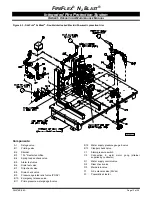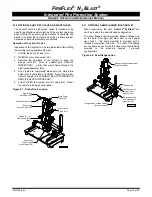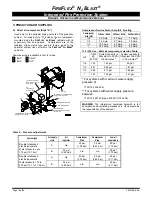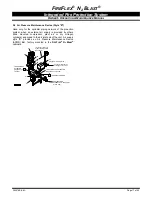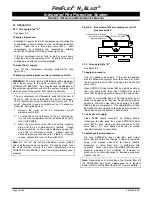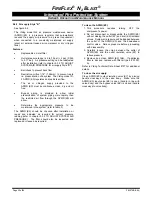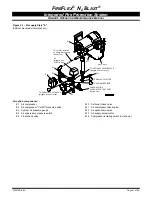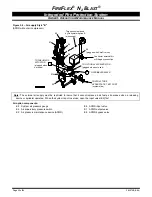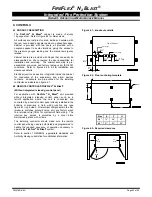
F
IRE
F
LEX
®
N
2
B
LAST
®
Integrated Fire Protection System
O
WNER
'
S
O
PERATION
&
M
AINTENANCE
M
ANUAL
Page 8 of25
FM-076B-0-6A
4.6 PLACING THE SYSTEM BACK IN SERVICE AFTER
OPERATION
See figures 4.3 & 4.4 at the end of the current section.
1. Verify that the system has been properly drained.
Main water supply control valve (
D1
) is CLOSED.
Main drain valve
(D3)
is OPEN. Emergency release
valve
(B10)
is CLOSED.
2. CLOSE main drain valve
(D3).
3. OPEN priming valve
(B1)
.
4. Restore supervisory pressure to sprinkler piping.
Note:
On systems provided with an air pressure
maintenance device (air option style "B"), verify that
the ½" by-pass valve
(E8)
in the air pressure
maintenance device trim is CLOSED and that both ¼"
valves
(E6 & E7)
are OPEN.
5. Nitrogen generator compressor will come on and the
“Operating” green light will illuminate until the N
2
storage tank pressure reaches maximum
(approximately 75 Psi) and the compressor shuts
off.Reset the remote release control panel. Solenoid
valve
(F1)
should close.
6. OPEN drain test valve
(B6)
.
7. PARTIALLY OPEN main water supply control
valve
(D1)
.
8. When full flow develops from the drain test
valve
(B6)
, CLOSE the drain test valve.
9. Verify that there is no flow from the drip check
valve (B7) when the plunger is pushed.
10. FULLY OPEN the main water supply control valve
(D1)
.
11. Verify that the alarm test valve
(B5)
is CLOSED and
that all other valves are in their "normal" operating
position.
12. Depress the plunger of the drip check valve
(B7)
. No
water should flow from the drip check when the
plunger is pushed.
13. Check and repair all leaks.
14. Notify the Authority Having Jurisdiction, remote
station alarm monitors, and those in the affected area
that the system is back in service.

















